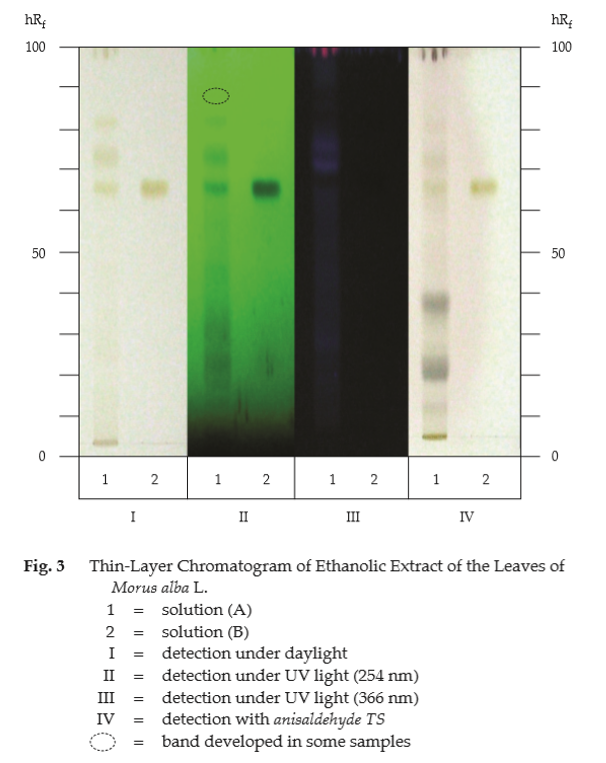ตำรามาตรฐานยาสมุนไพรไทย
Thai Herbal Pharmacopoeia
สำนักยาและวัตถุเสพติด กรมวิทยาศาสตร์การแพทย์ กระทรวงสาธารณสุข
Bureau of Drug and Narcotic, Department of Medical Sciences, Ministry of Public Health(Tinospora crispa (L.) Hook.f. & Thomson)
(Nelumbo nucifera Gaertn.)
(Centella asiatica (L.) Urb.)
(Centella Dry Extract)
(Centella Cream)
(Mesua ferrea L.)
(Piper sarmentosum Roxb.)
(Piper sarmentosum Roxb.)
(Pterocarpus santalinus L. f.)
(Santalum album L.)
(Senna tora (L.) Roxb.)
(Senna alata (L.) Roxb.)
(Senna Alata Tea)
(Piper retrofractum Vahl)
(Myristica fragrans Houtt)
(Andrographis paniculata (Burm. f.) Nees)
(Andrographis Capsules)
(Allium ascalonicum L.)
(Ocimum tenuiflorum L.)
(Curcuma longa L.)
(Turmeric Capsules)
(Turmeric Dry Extract)
(Turmeric Dry Extract Capsules)
(Arcangelisia flava (L.) Merr.)
(Curcuma sp.)
Harrisonia perforata (Blanco) Merr.
(Aristolochia pierrei Lecomte)
(Zingiber officinale Roscoe)
(Ginger Capsules)
(Ginger Tea)
(Cassia fistula L.)
(Nardostachys jatamansi (D. Don) DC.)
(Angelica sinensis (Oliv.) Diels)
Artemisia annua L.
(Ligusticum sinense Oliv. cv. Chuanxiong)
(Neopicrorhiza scrophulariiflora Pennell)
(Atractylodes lancea (Thunb.) DC.)
(Aucklandia lappa Decne)
(Terminalia chebula Retz.)
(Angelica dahurica (Hoffm.) Benth. & Hook. f. ex Franch. & Sav. var. dahurica)
(Kaempferia parviflora Wall. ex Baker)
(Hibiscus sabdariffa L.)
(Roselle Tea)
(Allium sativum L.)
(Zingiber zerumbet (L.) Sm.)
(Wurfbainia testacea (Ridl.) Škorničk.& A. D. Poulsen)
(Cannabis sativa L.)
(Myristica fragrans Houtt)
(Dracaena cochinchinensis (Lour.) S. C. Chen)
(Ficus racemosa L.)
(Hyptis suaveolens (L.) Poit.)
Clerodendrum indicum (L.) Kuntze
(Phyllanthus emblica L.)
(Citrus hystrix DC.)
(Citrus hystrix DC.)
(Areca catechu L.)
(Momordica charantia L.)
Moringa oleifera Lam.
(Aegle marmelos (L.) Corrêa)
(Solanum trilobatum L.)
(Morus alba L.)
Gynostemma pentaphyllum(Thunb.)
Makino
(Clinacanthus nutans (Burm. f.) Lindau)
(Cissus quadrangularis L.)
(Mimusops elengi L.)
(Zingiber montanum (J. König) Link. ex A. Dietr.)
(Piper betle L.)
(Capsicum annuum L.)
(Capsicum Oleoresin)
(Capsicum Gel)
(Piper nigrum L.)
(Piper nigrum L.)
(Eurycoma longifolia Jack)
(Thunbergia laurifolia Lindl.)
(Piper wallichii (Miq.) Hand.-Mazz.)
Senna garrettiana (Craib) H. S. Irwin & Barneby
(Terminalia bellirica (Gaertn.) Roxb.)
(Terminalia chebula Retz.)
(Caesalpinia bonduc (L.) H. Roxb.)
(Tarlmounia elliptica (DC.) H. Rob., S. C. Keeley, Skvaria & R. Chan)
(Hog Creeper Vine Dry Extract Capsiles)
(Hog Creeper Vine Dry Extract)
(Brachypterum scandens (Roxb.) Miq.)
(Lepidium sativum L.)
(Nigella sativa L.)
(Cuminum cyminum L.)
(Foeniculum vulgare Mill.)
(Plantago ovata Forssk.)
(Pimpinella anisum L.)
(Carum carvi L.)
(Anethum graveolens L.)
(Trachyspermum ammi (L.) Sprague)
Albizia procera (Roxb.) Benth.
(Acorus calamus L.)
(Tiliacora triandra (Colebr.) Diels)
Cyanthillium cinereum (L.) H. Rob.
(Orthosiphon aristatus (Blume) Miq.)
Murdannia loriformis (Hassk.) R. S. Rao & Kammathy
(Capparis micracantha DC.)
(Chrysopogon zizanioides (L.) Roberty)
(Cyperus rotundus L.)
(Cannabis sativa L.)
(Syzygium aromaticum (L.) Merr. & L. M. Perry)
(Boesenbergia rotunda (L.) Mansf.)
(Acanthus ebracteatus Vahl)
(Acanthus ilicifolius L.)
(Kaempferia galanga L.)
(Curcuma comosa Roxb.)
Betula alnoides Buch.-Ham. ex D. Don
Cannabis sativa L.
Carthamus tinctorius L
Mitragyna speciosa (Korth.) Havil
Mallotus repandus (Rottler) Müll. Arg
Azadirachta indica A. Juss. var. siamensis Valeton
Azadirachta indica A. Juss. var. siamensis Valeton
Punica granatum L.
Rhinacanthus nasutus (L.) Kurz
Baliospermum solanifolium (Burm.) Suresh
Curcuma aeruginosa Roxb
Boesenbergia kingii Mood & L. M. Prince
Senegalia rugata (Lam.) Britton & Rose
Acacia concinna (Willd.) DC.
Senegalia rugata (Lam.) Britton & Rose
Acacia concinna (Willd.) DC.
Senna alexandriana Mill. var. alexandriana
Cassia acutifolia Delile, Cassia angustifolia Vahl
Butea superba Roxb. ex Willd.
[Plaso superba (Roxb. ex Willd.) Kuntze, Rudolphia superba (Roxb. ex Willd.) Poir.
Pueraria candollei Graham
ex Benth. var. mirifica (Airy Shaw & Suvat.) Niyomdham
Streblus asper Lour.
Suregada multiflora (A. Juss.) Baill. (Gelonium
multiflorum A. Juss.
Mulberry Leaf is the dried leaf of Morus alba L. (Family Moraceae), Herbarium Specimen Number: DMSC 5157, Crude Drug Number: DMSc 5431, 5432.
Constituents Mulberry Leaf contains flavonoids (e.g., rutin, quercetin 3-(6-malonyl) glucoside, isoquercitrin), alkaloids (e.g., 1-deoxynojirimycin), sterols, etc.
Description of the plant (Figs. 1a, 1b) Deciduoustree or shrub, 3 to 15(–20) m tall; stem erect, branched; young branch greenish, pubescent; mature branch greyish green with lenticels; lenticel prominent, reddish or yellowish brown; stem bark thin, rough, shallowly furrowed, grey, reddish or yellowish brown; bud ovoid, 4 to 6 mm long. Leaves simple, alternate, variable in size and shape, usually ovate to broadly ovate, (2.5–)5 to 20(–30) cm long, 2.5 to 14 cm wide, apex acute, acuminate or obtuse, base truncate, round or cordate, margin serrate, serrate-crenate, or irregularly lobed, basal nerves 3, blade abaxially glabrous or sparingly pubescent along major veins or tufted in axils of principle lateral veins and midrib, adaxially glabrous or sparsely pubescent; petiole up to 5.5 cm long; stipule ovate to lanceolate, 5 to 9 mm long, caducous. Inflorescence catkin, axillary, sordid white or greenish white, monoecious or dioecious; male catkin lax, 1 to 4 cm long; female catkin ovoid, 0.5 to 2 cm long; peduncle as long as the catkin. Male flower sessile; sepals 4, imbricate, ovoid, about 2.5 mm long, glabrous or hairy; stamens 4, filament inflexed in buds, anther globose to reniform, 2-loculed, papillose. Female flower sessile; sepals 4, imbricate, glabrous, marginally hairy; ovary 1-celled, glabrous, style, 0.5 to 1 mm long, 2-partite, stigma papillose. Fruit multiple, syncarpous, ovoid, ellipsoid or cylindric, 1 to 2.5 cm long, 0.5 to 1 cm wide, fleshy, becoming reddish, purplish, blackish or whitish when mature.
Description Odour, slightly aromatic; taste, slightly sweet with slightly bitter aftertaste.
Macroscopical (Fig. 1a) Lamina ovate to broadly ovate, irregularly lobed, 5 to 15 cm long, 4 to 10 cm wide, apex acute, acuminate or obtuse, base round to cordate, margin coarsely serrate to crenate, vein prominent; petiole, if present, slender, up to 5.5 cm long.
Microscopical (Figs. 2a, 2b, 2c) Transverse section of the leaf through the midrib and the lamina shows upper and lower epidermises, mesophyll, vascular tissue, and collenchyma. Upper epidermis, a layer of large rectangular cells; large lithocysts forming papillae, some of which boundary cells also contain cystoliths, covered with cuticle layer and unicellular trichomes. Mesophyll composed of a layer of palisade cells and layers of irregular spongy cells, xylem and phloem. Xylem composed of spiral and reticulate vessels. Collenchyma cells, located beneath upper and lower epidermises of the midrib. Lower epidermis, a layer of small oval cells; numerous anomocytic stomata, covered with cuticle layer and unicellular trichomes.
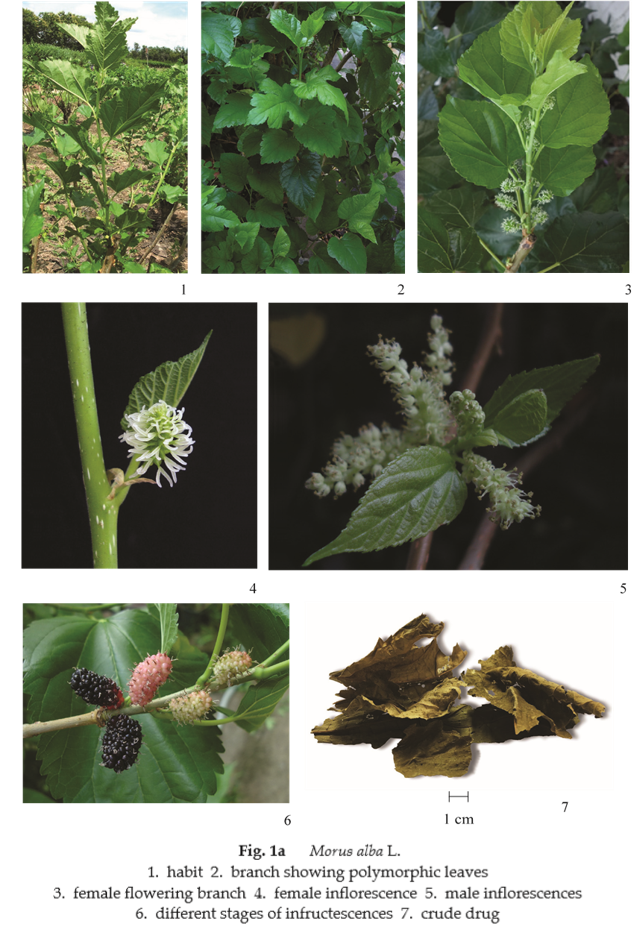
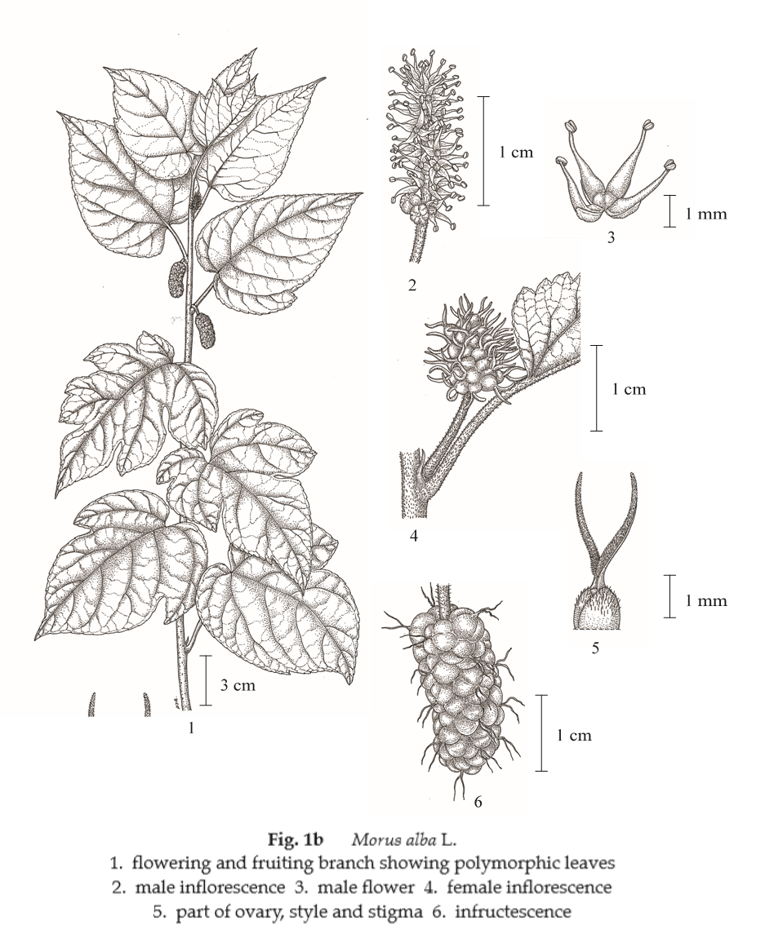
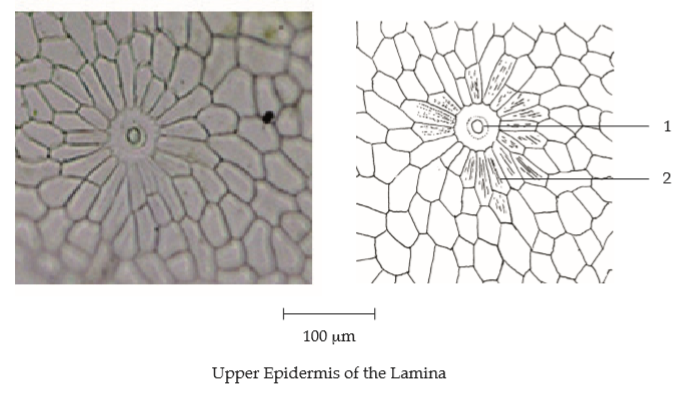
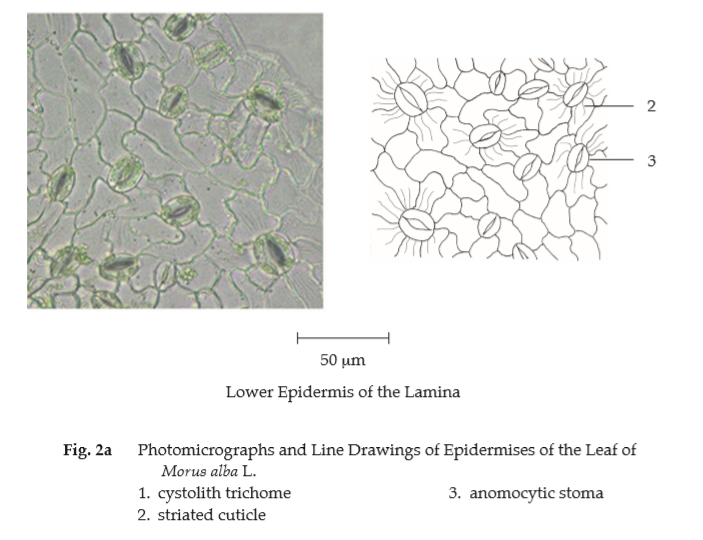
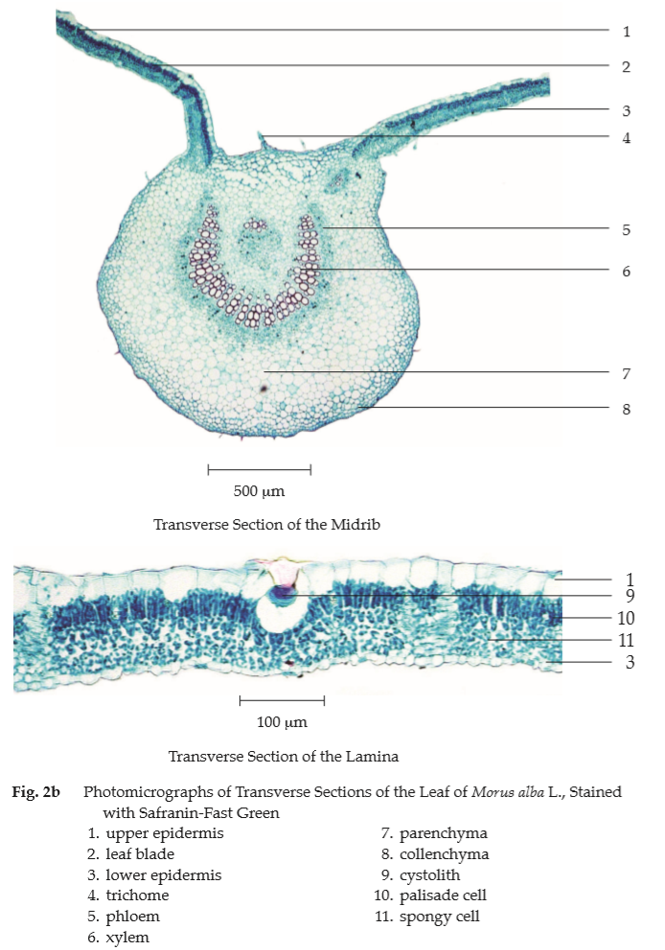

Mulberry Leaf in powder possesses the diagnostic microscopical characters of the unground drug. Upper epidermis, large rectangular cells, some with cystoliths; lower epidermis, small oval cells with anomocytic stomata; epidermis of the vein with cicatrix; epidermis with striated cuticle; and unicellular trichomes are characteristic.
Packaging and storage Mulberry Leaf shall be kept in well-closed containers, protected from light, and stored in a dry place.
Identification
A. Warm 500 mg of the sample, in No. 250 powder, with 10 mL of water on a water-bath for 15 minutes and filter (solution 1). To 1 mL of solution 1, add 3 or 4 pieces of magnesium ribbon, shake well, and mix with 1 or 2 drops of hydrochloric acid: a brownish red colour develops.
B. To 2 mL of solution 1, add 1 or 2 drops of a 5 per cent w/v solution of iron(III) chloride: a greenish brown precipitate is produced.
C. Carry out the test as described in the “Thin-Layer Chromatography” (Appendix 3.1), using silica gel GF254 as the coating substance and a mixture of 80 volumes of ethyl acetate, 20 volumes of acetone, 20 volumes of formic acid and 20 volumes of water as the mobile phase and allowing the solvent front to ascend 8.5 cm above the line of application. Apply separately to the plate as bands of 10 mm, 5 μL each of the following two solutions. Prepare solution (A) by shaking 1 g of the sample, in No. 250 powder, in 10 mL of ethanol (30 per cent), warming in a water-bath at 50° for 10 minutes, filtering, and washing the filtrate with three 10-mL portions of n-hexane. Evaporate the ethanolic layer on a water-bath to dryness and dissolve in 1 mL of ethanol (30 per cent). For solution (B), dissolve 1 mg of rutin in 1 mL of methanol. After removal of the plate, allow it to dry in air and examine under daylight, locating the bands. The chromatogram obtained from solution (A) shows a yellow band (hRf value 65 to 67) corresponding to the rutin band from solution (B), and other two yellow bands. Subsequently examine the plate under ultraviolet light (254 nm), marking the quenching bands. One quenching band corresponding to the rutin band from solution (B) and other three quenching bands are observed. Examine the plate under ultraviolet light (366 nm) through the cut-off filter; two blue fluorescent bands are observed. Spray the plate with anisaldehyde TS and heat at 105° for 3 minutes; the band due to rutin is yellow. Other yellow and yellowish grey bands are also observed (Table 1); see also Fig. 3.
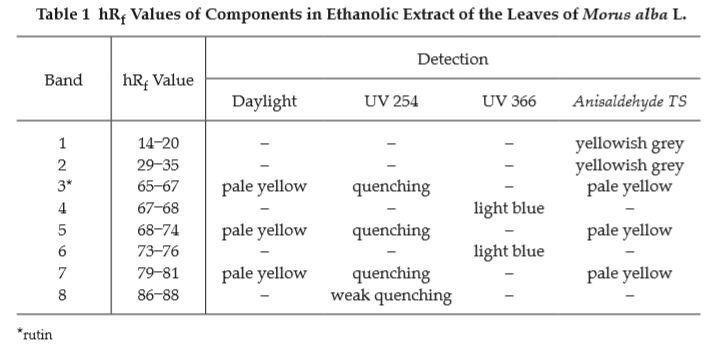
Loss on drying Not more than 11.0 per cent w/w after drying at 105° to constant weight (Appendix 4.15).
Foreign matter Not more than 2.0 per cent w/w (Appendix 7.2).
Acid-insoluble ash Not more than 5.0 per cent w/w (Appendix 7.6).
Total ash Not more than 11.0 per cent w/w (Appendix 7.7).
Ethanol-soluble extractive Not less than 4.0 per cent w/w (Appendix 7.12).
Water-soluble extractive Not less than 17.0 per cent w/w (Appendix 7.12).
Dose 5 to 10 g a day.
